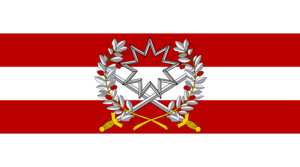Skarmian Defence Services
This article is incomplete because it is pending further input from participants, or it is a work-in-progress by one author. Please comment on this article's talk page to share your input, comments and questions. Note: To contribute to this article, you may need to seek help from the author(s) of this page. |
| Skarmian Defence Services | |
|---|---|
| Ieskarmiket Sluzbai Ichur Sluzhby Oborony Skarmii | |
 Flag of the Skarmian Defense Services | |
| Founded | 30 April 1999 |
| Service branches | |
| Headquarters | Zalsoker, Skarmia |
| Website | www.sluzbai.gov.sa |
| Leadership | |
| Commander-in-chief | |
| Prime Minister | |
| Minister of Defence | |
| Chief of Defense Services | |
| Manpower | |
| Military age | 18–30 years old |
| Conscription | 18 years of age, 12 months |
| Reaching military age annually | (2011 est.) |
| Active personnel | 38,300 (2021) |
| Expenditures | |
| Budget | 19.8 billion SKR (2021) 302,300,000 Zamastanian ziapet (2021) |
| Industry | |
| Domestic suppliers | SkarmAir Aircraft Manufacturing Technology Centre Delta RG Automotive Government Weapons Initiative |
| Related articles | |
| History | Military history of Skarmia List of wars involving Skarmia List of equipment of the Skarmian Defense Services |
| Ranks | Military ranks of Skarmia |
The Skarmian Defence Services (Skarmic: Ieskarmiket Sluzbai Ichur, IPA: [ ]; Beleroskovi: Sluzhby Oborony Skarmii, IPA: [ ]) are the unified military forces of the Federation of Skarmia. The Skarmian Defence Services consist of the Skarmian Army, the Skarmian Navy, the Skarmian Air Force, the Highlander Guards and Skarmian Military Intelligence. The national defence policy aims to guarantee the preservation of the independence and sovereignty of the state, the integrity of its land area, territorial waters, airspace and its constitutional order.
History
During the long period when Skarmia was under Beleroskovi control (as the Southwestern Krai), military defence of the region was twofold - the Imperial military defended its borders, but many of the Skarmic tribes regularly collaborated with Beleroskovi military interests, operating semi-independently as vassals of the Empire. Numerous Skarmic hosts pledged their own loyalty to the Empire directly, and for many years, this policy of Skarmic tribesmen independently fighting alongside Imperial forces, often with written contracts promising generous pay for their mercenary work, was codified in law, forming a great deal of the basis for the current iteration of the Skarmic tribal hierarchy. However, in 1867, as it became more apparent that hiring Skarmic mercenaries was an inferior policy to holding a standing army, the Empire formed the Highlander Guard, comprised mainly of ethnic Skarmic people, and with many of the hosts that had subjected themselves willingly to the Empire.